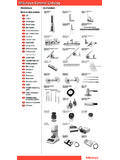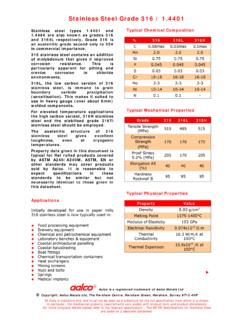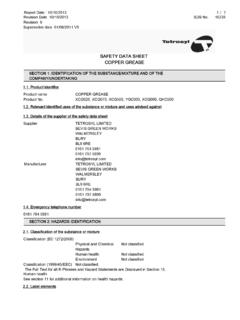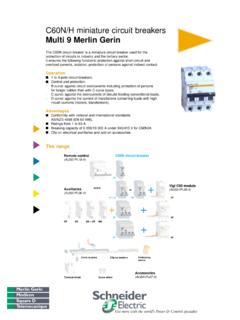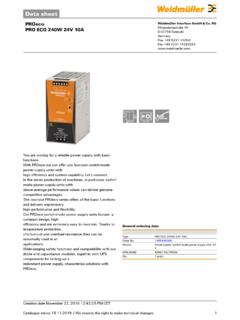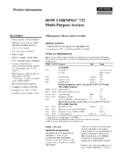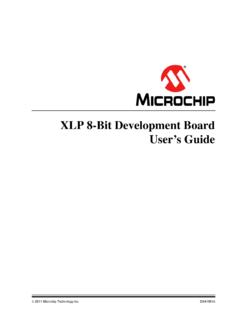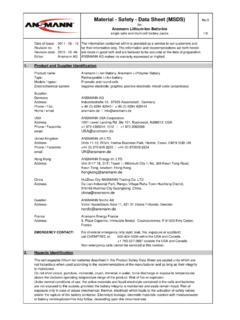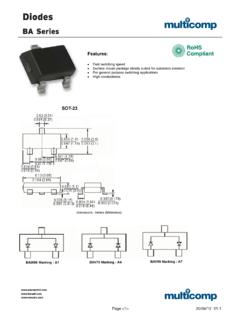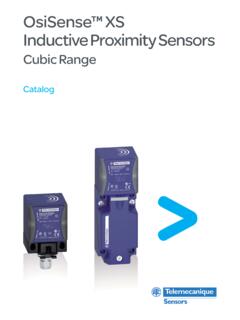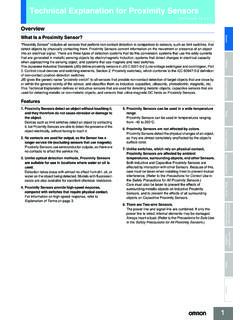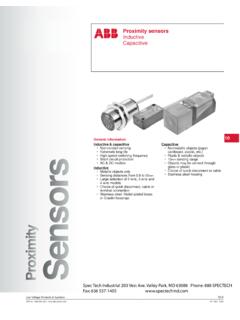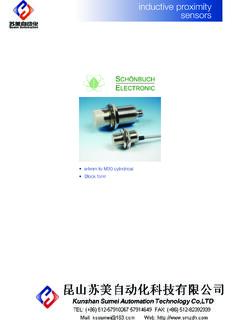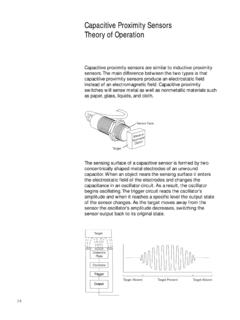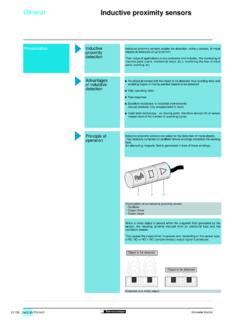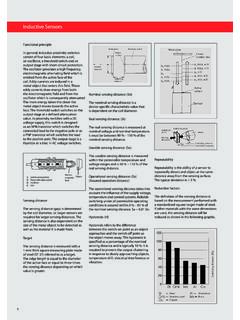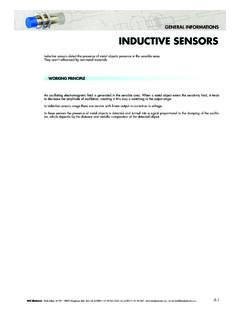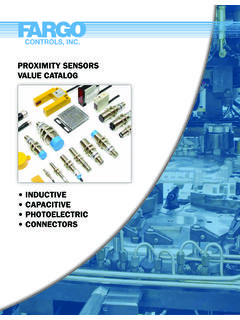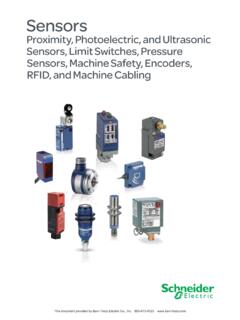Transcription of Inductive proximity sensors - Farnell element14
1 ElectricGeneralInductive proximity sensors0 RecommendationsThe sensors described in this catalogue are designed to be used in standard industrial presence detection sensors do not have a redundant electrical circuit as would be needed to allow them to be used in safety safety applications, consult our Safety solutions using Preventa catalogue No. and certifications Parameters related to the environmentQuality controlsOur Inductive proximity sensors are subject to specific precautions guaranteeing their reliability in the harshest industrial vThe product characteristics stated in this catalogue are subject to a qualification procedure carried out in our products are notably subjected to climatic cycle tests for 3000 hours with their supply on to check their ability to hold their characteristics over time.
2 BProductionvThe electrical characteristics and detection distances at both ambient temperature and extreme temperatures are 100% are sampled at random during production and are subjected to monitoring tests relating to all their qualified returnsIf, in spite of all these precautions, defective products are returned to us, they are subject to systematic analysis and corrective actions are taken to eliminate the risks of the fault to standardsAll Telemecanique brand proximity sensors conform to the standard IEC 60947-5-2 Mechanical shock resistanceThe sensors are tested in accordance with the standard IEC 60068-2-27, 50 gn, duration 11 resistanceThe sensors are tested in accordance with the standard IEC 60068-2-6, amplitude 2 mm, f = Hz, 25 gn at 55 to the environment: IPbPlease refer to the characteristics pages for the various 67: protection against the effects of immersion.
3 Test conforming to IEC 60529: sensor immersed for 30 minutes in 1 m of deterioration in either operating or insulation characteristics is 68: protection against prolonged immersion. The test conditions are subject to agreement between the manufacturer and the user ( machine-tool applications or other applications on any other machine drenched in cutting fluids).Resistance to magnetic interferenceTelemecanique Inductive proximity sensors are tested in accordance with the recommendations of the standard IEC to electromagnetic interferencebElectrostatic dischargesVersions a and z: level 4 immunity (15 kV).IEC 61000-4-2bRadiating electromagnetic fields (electromagnetic waves)Versions c, a and z : level 2 immunity (3 V/m) or level 3 immunity (10 V/m).
4 IEC 61000-4-3bFast transients (motor start/stop interference)Version c: level 3 immunity (1 kV).Versions a and z: level 4 immunity (2 kV) except 8 mm model (level 2). IEC 61000-4-4bImpulse voltageVersions c, a and z : level 3 immunity ( kV) except 8 mm and smaller models (1 kV level). IEC 60947-5-2 Resistance to chemicals in the environmentbOwing to the very wide range of chemicals encountered in modern industry, it is very difficult to give general guidelines common to all sensors . bTo ensure lasting efficient operation, it is essential that the chemicals coming into contact with the sensors will not affect their casings and, in doing so, prevent their reliable and flat plastic case sensors offer an excellent overall resistance to: vchemical products such as salts, aliphatic and aromatic oils, fuel oils, acids and diluted bases.
5 For alcohols, ketones and phenols, preliminary tests should be made relating to the nature and concentration of the and food industry products such as animal or vegetable based food products (vegetable oils, animal fat, fruit juice, dairy proteins, etc.).In all cases, the materials selected (see product characteristics) provide satisfactory compatibility in most industrial environments (for further information, please consult your Regional Sales Office).InsulationClass 2 devices iElectrical insulation conforming to the standards IEC 61140 and NF C 20-030 concerning electric shock protection 25 C%Temperature CHumidity as a %- 25 + 70 C cycle, 95% RHTemperatureRelative ElectricGeneralInductive proximity sensors0 Principle of Inductive detectionOperating principle1 Oscillator2 Output driver3 Output stagebInductive proximity sensors are solely for the detection of metal basically comprise an oscillator whose windings constitute the sensing alternating magnetic field is generated in front of these of an Inductive proximity sensorDetection of a metal object bWhen a metal object is placed within the magnetic field generated by the sensor .
6 The resulting currents induced form an additional load and the oscillation causes the output driver to operate and, depending on the sensor type, a normally open (NO) or normally closed (NC) output signal is proximity detectionbInductive proximity sensors enable the detection, without contact, of metal objects. bTheir range of application is very extensive, and includes: vthe monitoring of machine parts (cams, stop, etc.),vmonitoring the flow of metal parts, counting, etc.,Advantages of Inductive detectionbNo physical contact with the object to be detected, thus avoiding wear and enabling fragile or freshly painted objects to be operating rates. Fast resistance to industrial environments (robust products fully encapsulated in resin).bSolid-state technology: no moving parts, therefore service life of sensor independent of the number of operating sensors are suitable for all metal environments (flush mountable or non flush mountable) as they provide for a maximum sensing distance even in the presence of a metal background.
7 Precision detection of the object s position can be provided by means of the teach mode. For further information, see page 37316/2 Output LEDO utput LEDAll Telemecanique brand Inductive proximity sensors incorporate an output state LED sensors are provided with a green LED which indicates the presence of the voltage and guides the user during setting-up (teach mode)Mounting of sensors on a metal supportSensors suitable for flush mounting in metalbNo side clearance models using the Osiconcept system are flush mountable in the metal without reducing the sensing distance and even allow an object to be detected against a metal background. For further information, see page not suitable for flush mounting in metalbSide clearance requiredSensing distance greater than a standard flush mountable Osiconcept system eliminates the side clearance requirement.
8 For further information, see page presentNo object presentN/O outputN/C output3 SnDetected objectMetalMetal3 Sn2 SnDetected ElectricGeneralInductive proximity sensors0 Mounting of sensors on a metal supportMounting in conjunction with fixing bracketbStandard flush mountable models: e = 0, h = 0bStandard non flush mountable modelsv / 8 / 12 mm: e = 0, h = 0v 18 mm: if h = 0, e u 5; e = 0, h u 3. 30 mm: if h = 0, e u 8; e = 0, h u models: e = 0, h = 0 Mounting distance between sensorsStandard sensorsTwo sensors mounted too close to each other are likely to lock in the "detection state", due to interference between their respective oscillating avoid this condition, minimum mounting distances given for the sensors should be adhered to or sensors with staggered oscillating frequencies frequency sensorsFor applications where the minimum recommended mounting distances for standard sensors cannot be achieved, it is possible to overcome this restraint by mounting a staggered frequency sensor adjacent or opposite to each standard sensor .
9 For information on staggered frequency sensors , please consult your Regional Sales torque for cylindrical type sensorsMaximum tightening torque for the various sensor case materialsBrassBrassStainless steelPlasticDiameter of sensor in mmShort case modelForm A modelForm A modelAll modelsXS5ppB1XS6ppB1XS6ppB2XS5 AVpXS1ppXS2ppXS4 Ppp 85 126 1815 3040 (mm)h (mm)Non ferrous orplastic materialeeMounting side by sidee u 2 SnMounting face to facee u 10 ElectricGeneralInductive proximity sensors0 Sensing distanceDefinitionsTo allow customers to make reliable comparisons and selections, the IEC 60947-5-2 standard defines various sensing distances such as:bNominal sensing distance (Sn)The rated operating distance for which the sensor is designed.
10 It does not take into account any variations (manufacturing tolerances, temperature, voltage).bReal sensing distance (Sr)The real sensing distance is measured at the rated voltage (Un) and at the rated ambient temperature (Tn). It must be between 90 % and 110 % of the real sensing distance (Sn): Sn Sr sensing distance (Su)The usable sensing distance is measured at the limits of the permissible variations in the ambient temperature (Ta) and the supply voltage (Ub). It must be between 90 % and 110 % of the real sensing distance: Sr Su operating distance (Sa). This is the operating zone of the sensor . The assured operating distance is between 0% and 81% of the nominal sensing distance (Sn): 0 Sa x x SnStandard metal targetThe IEC 60947-5-2 standard defines the standard metal target as a square mild steel (Fe 360) plate, 1 mm side dimension of the plate is either equal to the diameter of the circle engraved on the active surface of the sensing face, or 3 times the nominal sensing distance (Sn).
